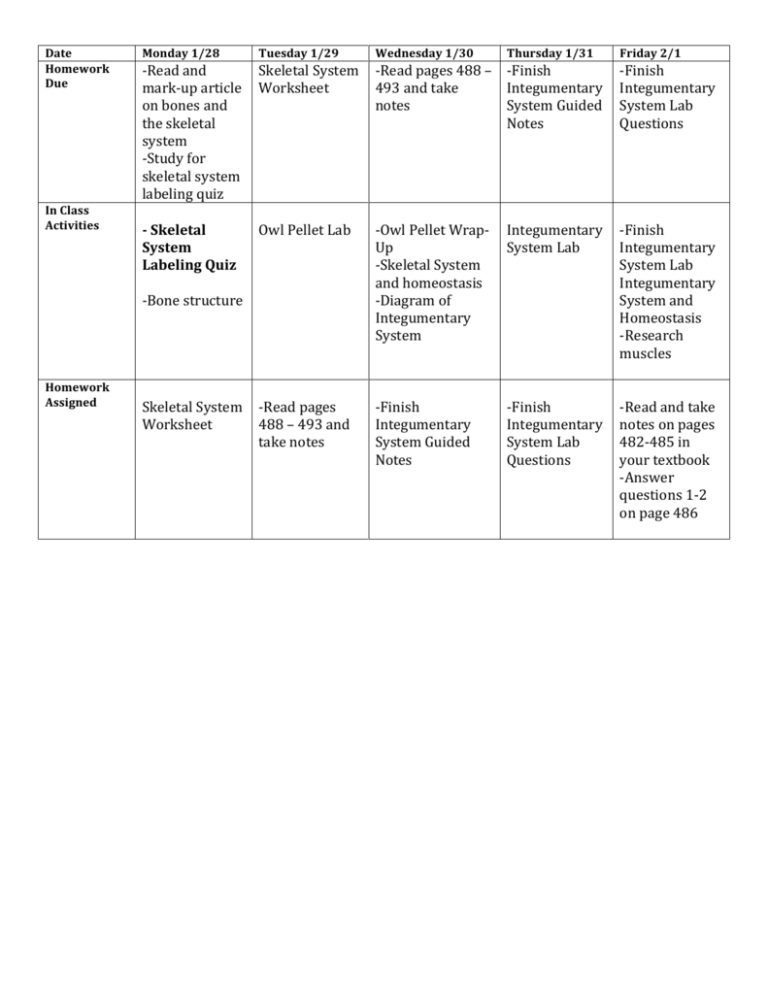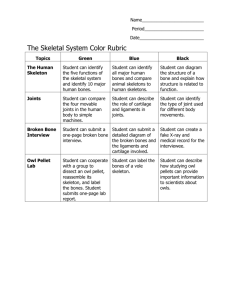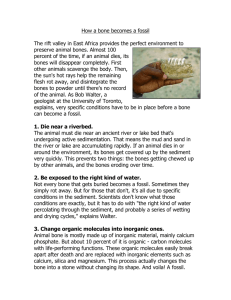-‐Read and mark-‐up article on bones and the skeletal system
advertisement

Date Homework Due In Class Activities Homework Assigned Monday 1/28 Tuesday 1/29 -­‐Read and mark-­‐up article on bones and the skeletal system -­‐Study for skeletal system labeling quiz -­‐ Skeletal System Labeling Quiz -­‐Bone structure Skeletal System -­‐Read pages 488 – -­‐Finish Worksheet 493 and take Integumentary notes System Guided Notes Owl Pellet Lab Skeletal System -­‐Read pages Worksheet 488 – 493 and take notes Wednesday 1/30 -­‐Owl Pellet Wrap-­‐ Up -­‐Skeletal System and homeostasis -­‐Diagram of Integumentary System -­‐Finish Integumentary System Guided Notes Thursday 1/31 Friday 2/1 -­‐Finish Integumentary System Lab Questions Integumentary -­‐Finish System Lab Integumentary System Lab Integumentary System and Homeostasis -­‐Research muscles -­‐Finish -­‐Read and take Integumentary notes on pages System Lab 482-­‐485 in Questions your textbook -­‐Answer questions 1-­‐2 on page 486 Name _____________________________________________________ Skeletal System Questions 1. What are the 2 types of bone tissue? ____________________________________________________________________________ 2. Are bones alive? _____________________________ 3. What is the outer membrane called? _____________________________________________________ 4. What is contained in the medullary cavity? _________________________________________________________________ 5. How much does the average skeleton weigh? _____________________________________________________ 6. If we replaced our skeletons with steel, how much would it weigh? _________________________________________ 7. Why would steel not be as good as bone in making up our skeletons? _______________________________________ _________________________________________________________________________________________________________________________ 8. What does spongy bone do? _________________________________________________________________________________________________________________________ _________________________________________________________________________________________________________________________ _________________________________________________________________________________________________________________________ 9. What does compact bone do? _________________________________________________________________________________________________________________________ _________________________________________________________________________________________________________________________ _________________________________________________________________________________________________________________________ 10. How does the bone handle stress? _________________________________________________________________________________________________________________________ _________________________________________________________________________________________________________________________ _________________________________________________________________________________________________________________________ 11. When impact occurs on bones, what happens? _________________________________________________________________________________________________________________________ _________________________________________________________________________________________________________________________ _________________________________________________________________________________________________________________________ Questions to consider as a group: 1. Why is bone better suited to be a skeleton than steel? _________________________________________________________________________________________________________________________ _________________________________________________________________________________________________________________________ _________________________________________________________________________________________________________________________ _________________________________________________________________________________________________________________________ 2. What makes bones both lightweight and strong? _________________________________________________________________________________________________________________________ _________________________________________________________________________________________________________________________ _________________________________________________________________________________________________________________________ _________________________________________________________________________________________________________________________ 3. How do bones support the BIG 7 in humans? _________________________________________________________________________________________________________________________ _________________________________________________________________________________________________________________________ _________________________________________________________________________________________________________________________ _________________________________________________________________________________________________________________________ 4. How do bones help us maintain homeostasis? _________________________________________________________________________________________________________________________ _________________________________________________________________________________________________________________________ _________________________________________________________________________________________________________________________ _________________________________________________________________________________________________________________________ Names: ________________________________________________________________________________ Owl Pellet Lab: Hoot and Hurl 1. Describe the pellet: Characteristic Length (cm) Width (cm) Mass (g) Do you see any signs of fur? Do you see any signs of feathers? Measurements/Information Qualitative Descriptions: 2. VERY CAREFULLY separate the bones from the fur and feathers. Use the twisting method! Place similar bones into piles for counting purposes. 3. Counting and inspecting bones: Bone Type Count Whooo did they come from? Skulls Mandible Scapula Radius Ulna Humerus Phalanges Vertebra Ribs Pelvis Femur Tibia/Fibula Bird Bones Other 4. Carefully reconstruct the skeleton on a separate sheet of paper. Analysis 1. What do we know about the digestive system of an owl based upon the pellets? 2. Owls, hawks, and eagles are types of raptors, animals that have hooked beaks and sharp claws, and are therefore adapted for seizing prey animals. Hawks and eagles differ from owls in that they eat their prey animals by tearing them into small pieces, picking out the flesh and avoiding most of the fur and bones. They also have strong stomachs that can digest most of the bone material that they might eat. The relatively small amount of indigestible bone and fur that remain will be compacted by their stomach muscles into a pellet similar to the owls’. Do you think an eagle pellet would be as useful for dissecting as an owl's? Why or why not? 3. We’ve been talking about how strong and lightweight bones are due to their structure. The layers of compact bone make for strong bones while the spongy bone on the inside makes them lightweight. Additionally, bones store minerals, such as calcium and phosphorus, which make the bones very hard. How did the bones found in the owl pellets compare to the strong bones that we’ve been discussing? What do you think the reasons might be for any differences or similarities? 4. What types of joints did you observe after you put the bones back together? Name: _____________________________________________ The Integumentary System: Skin, Glands, Hair, and Nails 5 Functions: 1. ______________________________________________________________________________________________________________________ -­‐ Keeps out ___________________________________________________________________________________________________________ -­‐Keeps in _____________________________________________________________________________________________________________ 2. ______________________________________________________________________________________________________________________ -­‐Blood vessels run through the skin that constrict or dilate to decrease or increase blood flow to an area -­‐_______________________________________________________________________________________________________________________ 3. ______________________________________________________________________________________________________________________ -­‐ Skin helps remove waste from your body during _______________________________________________________________ ________________________________________________________________________________________________________________________ 4. ______________________________________________________________________________________________________________________ -­‐ Nerves on the skin provide information about __________________________________________________________________ __________________________________________________________________ 5. ______________________________________________________________________________________________________________________ -­‐_______________________________________________________________________________________________________________________ 3 Layers: 1. Epidermis -­‐ Location: -­‐ Made of: ____________________________________________________________________________________________________________ _________________________________________________________________________________________________________________________ -­‐ Cells remain in the epidermis for and then ____________________________________________________________________________________________________ -­‐ Function: 1. ______________________________________________________________________________________________________________________ 2. ______________________________________________________________________________________________________________________ 3. ______________________________________________________________________________________________________________________ Melanin: _____________________________________________________________________________________________________ _________________________________________________________________________________________________________________________ 2. Dermis -­‐ Location: -­‐ Contains: ____________________________________________________________________________________________________________ _________________________________________________________________________________________________________________________ Pores: ________________________________________________________________________________________________________ Follicles: _____________________________________________________________________________________________________ 3. Subcutaneous Layer -­‐Location: -­‐ Made of: ____________________________________________________________________________________________________________ _________________________________________________________________________________________________________________________ Functions: ____________________________________________________________________________________________________________ _________________________________________________________________________________________________________________________ Name: __________________________________________________________ Integumentary System Lab Station 1: Nerve Density 1. One person closes his/her eyes (subject) and the other person is the tester 2. Open the calipers to 5mm and gently place it on the forearm on the subject 3. Ask the subject if she/he can feel 1 or 2 points. Record data. 4. Move the calipers 1 mm closer together and repeat steps 2 and 3. 5. Continue to move the calipers 1 mm closer together (.5 mm if you need to go shorter than 1 mm) until it feels like 1 point rather than 2 to the subject. Be sure to record your data. 6. Now repeats steps 1 – 5 on the subject’s palm. Record your data. 7. Switch subject and tester and repeat for the new subject. Forearm Palm Distance Apart (mm) One or Two Points? Distance Apart (mm) One or Two Points? Station 2: How sweat keeps us cool 1. Take two thermometers, 1 cotton ball, a piece of cardboard, and 1 cup of water 2. Take the temperature of the two thermometers. 3. Dunk the cotton ball in the water and wrap it around the end of Thermometer 1. Let it sit for 2 minutes 3. Record the temperature on both thermometers 4. Using a piece of cardboard, fan both of the thermometers for 3 minutes (keep the cardboard at least 10 cm away from the thermometers). 5. Record the temperatures of both thermometers. Thermometer 1 Temperature Thermometer 2 Temperature (Wet cotton ball) (No cotton ball) Initial After 2 minutes After 3 minutes of fanning Station 3: How does fat in the subcutaneous tissue insulate us? 1. Record the temperature in the ice bucket ______________________________ 2. Stick your hand in the ice bucket and describe your observations to your partner. 3. Put your hand in the “blubber glove” and place it in the ice bucket. 4. Describe your observations to your partner. Condition Observations Bare hand in ice bucket Blubber glove in ice bucket Analysis: Station 1: 1. Which test area was more sensitive – your palm or your forearm? Why do you think this is? _________________________________________________________________________________________________________________________ _________________________________________________________________________________________________________________________ _________________________________________________________________________________________________________________________ _________________________________________________________________________________________________________________________ 2. What do your data tell you about the relative density of nerves in your palm and forearm? _________________________________________________________________________________________________________________________ _________________________________________________________________________________________________________________________ _________________________________________________________________________________________________________________________ _________________________________________________________________________________________________________________________ Station 2: 1. Which of the thermometers had a lower temperature after step 4? ________________________________________ 2. How does this activity relate to the role of skin in regulating body temperature? _________________________________________________________________________________________________________________________ _________________________________________________________________________________________________________________________ _________________________________________________________________________________________________________________________ _________________________________________________________________________________________________________________________ _________________________________________________________________________________________________________________________ _________________________________________________________________________________________________________________________ Station 3: 1. Which layer of the skin did the blubber represent? _________________________________________________________ 2. What is the function of this layer of skin in our bodies? _________________________________________________________________________________________________________________________ _________________________________________________________________________________________________________________________ _________________________________________________________________________________________________________________________ _________________________________________________________________________________________________________________________ THERE ARE QUESTIONS ON THE BACK!! DON’T STOP HERE!! For your consideration: 1. Would the epidermis be an effective barrier to protect our bodies if the cells were still living? Why or why not? _________________________________________________________________________________________________________________________ _________________________________________________________________________________________________________________________ _________________________________________________________________________________________________________________________ _________________________________________________________________________________________________________________________ _________________________________________________________________________________________________________________________ _________________________________________________________________________________________________________________________ _________________________________________________________________________________________________________________________ _________________________________________________________________________________________________________________________ 2. What areas of the human body do you think have the highest concentration of sweat glands and pores? Why do you think this? _________________________________________________________________________________________________________________________ _________________________________________________________________________________________________________________________ _________________________________________________________________________________________________________________________ _________________________________________________________________________________________________________________________ _________________________________________________________________________________________________________________________ _________________________________________________________________________________________________________________________ _________________________________________________________________________________________________________________________ _________________________________________________________________________________________________________________________









